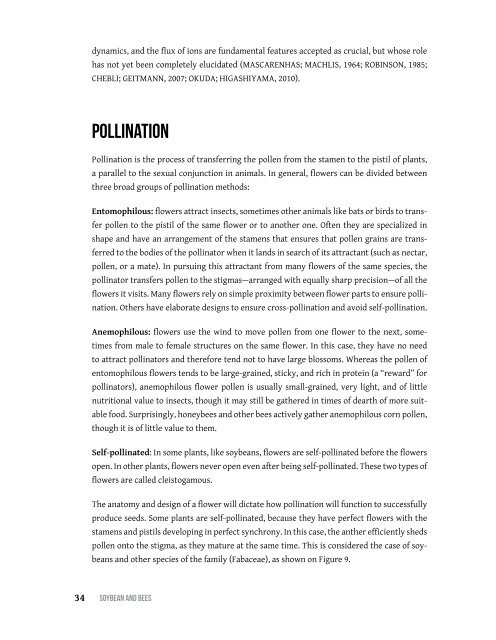Soybean and Bees
Create successful ePaper yourself
Turn your PDF publications into a flip-book with our unique Google optimized e-Paper software.
dynamics, <strong>and</strong> the flux of ions are fundamental features accepted as crucial, but whose role<br />
has not yet been completely elucidated (Mascarenhas; Machlis, 1964; Robinson, 1985;<br />
Chebli; Geitmann, 2007; Okuda; Higashiyama, 2010).<br />
Pollination<br />
Pollination is the process of transferring the pollen from the stamen to the pistil of plants,<br />
a parallel to the sexual conjunction in animals. In general, flowers can be divided between<br />
three broad groups of pollination methods:<br />
Entomophilous: flowers attract insects, sometimes other animals like bats or birds to transfer<br />
pollen to the pistil of the same flower or to another one. Often they are specialized in<br />
shape <strong>and</strong> have an arrangement of the stamens that ensures that pollen grains are transferred<br />
to the bodies of the pollinator when it l<strong>and</strong>s in search of its attractant (such as nectar,<br />
pollen, or a mate). In pursuing this attractant from many flowers of the same species, the<br />
pollinator transfers pollen to the stigmas—arranged with equally sharp precision—of all the<br />
flowers it visits. Many flowers rely on simple proximity between flower parts to ensure pollination.<br />
Others have elaborate designs to ensure cross-pollination <strong>and</strong> avoid self-pollination.<br />
Anemophilous: flowers use the wind to move pollen from one flower to the next, sometimes<br />
from male to female structures on the same flower. In this case, they have no need<br />
to attract pollinators <strong>and</strong> therefore tend not to have large blossoms. Whereas the pollen of<br />
entomophilous flowers tends to be large-grained, sticky, <strong>and</strong> rich in protein (a “reward” for<br />
pollinators), anemophilous flower pollen is usually small-grained, very light, <strong>and</strong> of little<br />
nutritional value to insects, though it may still be gathered in times of dearth of more suitable<br />
food. Surprisingly, honeybees <strong>and</strong> other bees actively gather anemophilous corn pollen,<br />
though it is of little value to them.<br />
Self-pollinated: In some plants, like soybeans, flowers are self-pollinated before the flowers<br />
open. In other plants, flowers never open even after being self-pollinated. These two types of<br />
flowers are called cleistogamous.<br />
The anatomy <strong>and</strong> design of a flower will dictate how pollination will function to successfully<br />
produce seeds. Some plants are self-pollinated, because they have perfect flowers with the<br />
stamens <strong>and</strong> pistils developing in perfect synchrony. In this case, the anther efficiently sheds<br />
pollen onto the stigma, as they mature at the same time. This is considered the case of soybeans<br />
<strong>and</strong> other species of the family (Fabaceae), as shown on Figure 9.<br />
34 SoybeAn <strong>and</strong> bees


